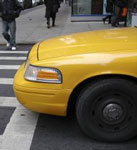Monday, September 10, 2007
 An unfamiliar void dotted the streets of New York City and Philadelphia on Wed., Sept. 5, 2007: the lack of taxis and their sometimes wild and raucous drivers. Longer lines were reported as riders waited at airports, hotels and shopping districts because many drivers took the day off to vent their frustration over new, in-cab payment requirements.
An unfamiliar void dotted the streets of New York City and Philadelphia on Wed., Sept. 5, 2007: the lack of taxis and their sometimes wild and raucous drivers. Longer lines were reported as riders waited at airports, hotels and shopping districts because many drivers took the day off to vent their frustration over new, in-cab payment requirements.
The 8,400-member New York Taxi Workers Alliance and the Taxi Workers Alliance of Philadelphia staged a two-day strike in protest of recent requirements that taxis must provide in-cab credit/debit card payment systems.
(VeriFone Transportation Systems is the preferred provider of the new integrated payment solutions in New York and the only such provider in Philadelphia. For more information, see “VeriFone corners NYC taxi business,” The Green Sheet, Aug. 13, 2007, issue 07:08:01)
Reports varied as to how many of New York's approximately 44,000 licensed cab drivers and Philly's 1,600 medallioned drivers participated in the strike. But it was enough to generate considerable attention on the street and in the media.
Due to the strike, emergency regulations were put in place that allowed cabbies to take multiple fares at once and offered special flat rates for certain fares, which likely helped to mitigate the problems associated with fewer available cabs.
By Thursday, more cab drivers were back on the job, but in both cities the message was made loud and clear: Many cabbies were not happy with the installation of ATM-style machines in their cabs. The drivers filed a list of complaints about the new technology required by the respective governing agencies.
Among the list of complaints were:
In response to drivers' complaints, Pete Bartolik of VTS, one of four systems providers in New York, said, "We were not aware of any significant glitches in the system."
He added that "not all technical issues are equipment-related. Some may be affected by the cars' mechanical problems, driver training and drivers' [unwillingness] to adapt to change."
However, National Public Radio reported that drivers in Philadelphia, who have been using the system for some time, say it is not reliable and causes frequent loss of contact with dispatchers.
#h3And yet more kvetching
Both drivers and customers have complained about slow dispatch times and other inefficiencies, such as drivers closest to the fares not always the ones to get dispatched.
Echoing the recent merchant complaints about credit card transaction fees, drivers are also protesting the nearly 5% fee levied on fares and tips by medallion owners to pay for processing charges.
Bartolik pointed out that "in the taxi industry, 5% is a very good deal – in some cities they may pay as much as 15%. Let's not forget that the NYC taxi industry was granted two rate hikes specifically to accommodate the migration to this technology.
"Finally, data from our implementation in Philadelphia shows that drivers benefit from higher tips when customers use card payment," mirroring reports from the restaurant industry which also show measurably higher tips for wait staff from patrons using credit cards rather than paying cash.
The reported three-week wait for payment is a mystery, as the Taxi and Limousine Commission (the agency that sets the rules for the implementation of the new devices) requires that all fleet drivers be paid for all transactions at the end of their shift.
Drivers have the option of daily direct deposit as well, and can monitor transactions online.
There remains the question of the touch-screen monitors for customers, which force drivers to be subjected to nearly nonstop noise and distraction.
While the system offers many advantages to the customer for a wide range of information, drivers have no control over the use of them, including volume levels. If used continuously, the constant chatter from the monitors, which includes advertising, could become a dangerous distraction to drivers.
Whether the strike had its desired effect or not, it's clear there are issues plaguing the successful rollout of automated payment systems in the taxi industry.

The Green Sheet Inc. is now a proud affiliate of Bankcard Life, a premier community that provides industry-leading training and resources for payment professionals. Click here for more information.
Notice to readers: These are archived articles. Contact names or information may be out of date. We regret any inconvenience.